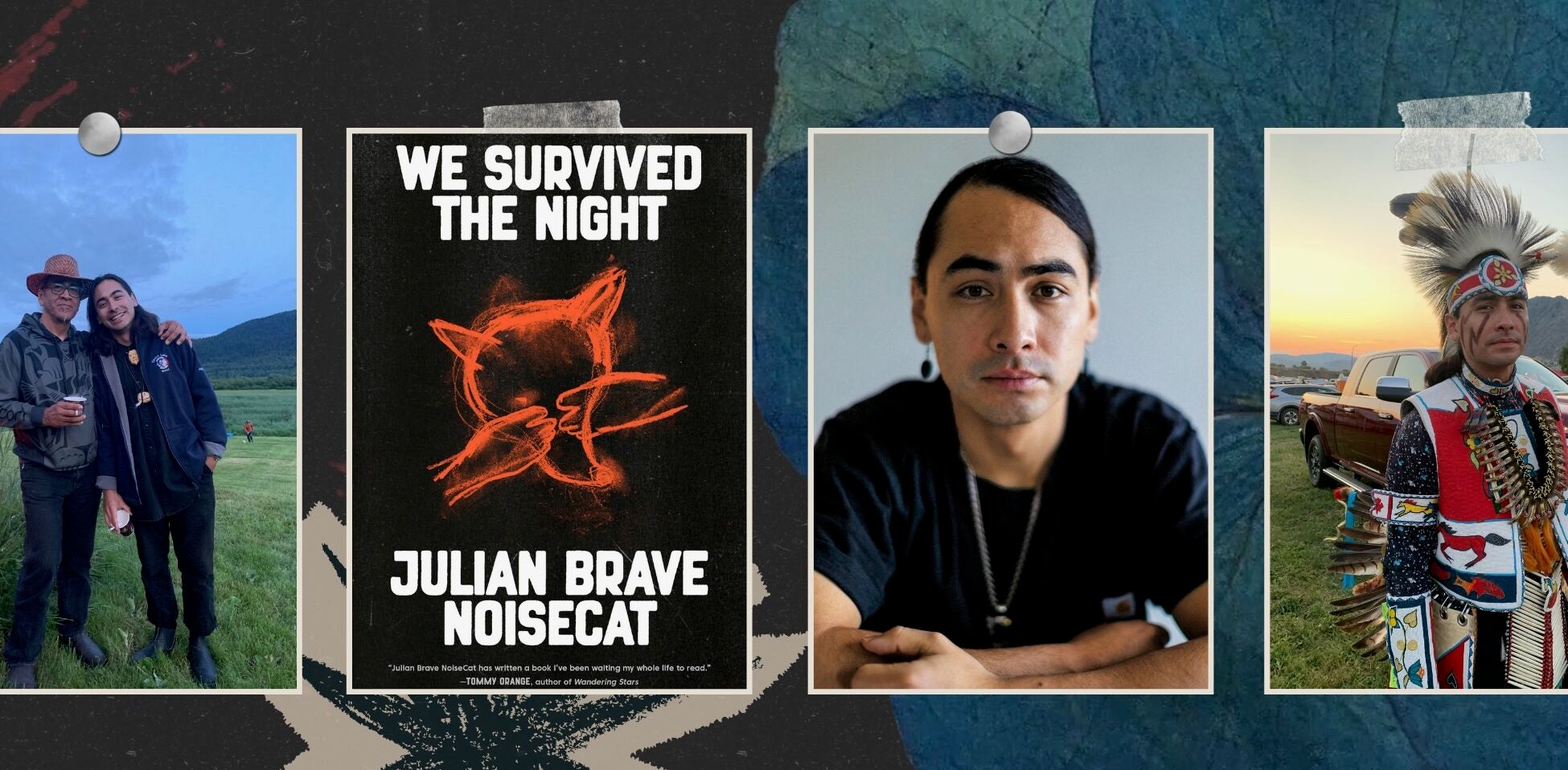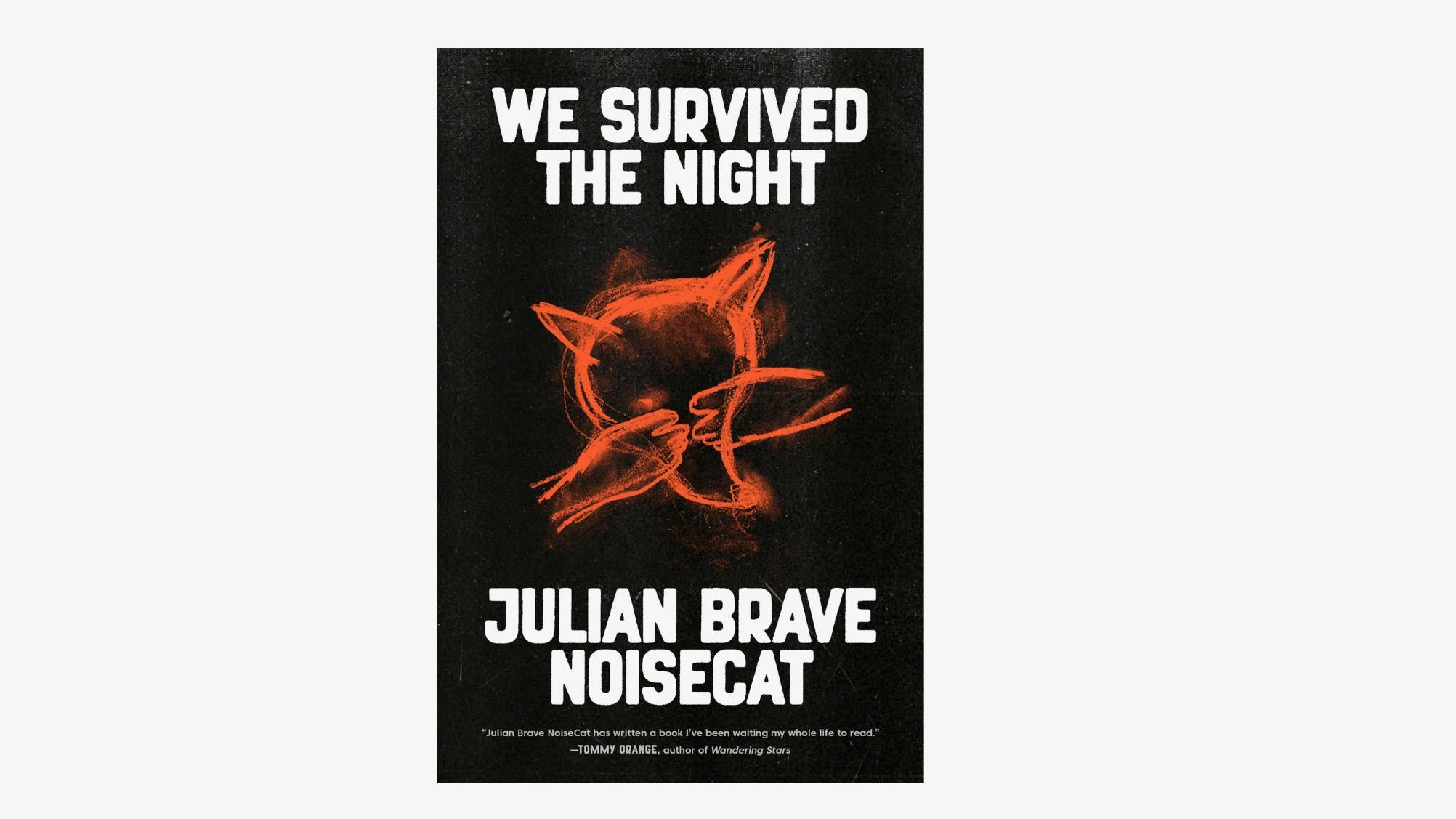If you buy through our links, we may earn an affiliate commission. This supports our mission to get more people active and outside.Learn about Outside Online's affiliate link policy
Coyote Comes to Life in Julian Brave NoiseCat's 'We Survived the Night'

We Survived the Night Book (Photo: Emily Kassie/ Penguin Random House// Canva and Ayana Underwood)
Perhaps you’ve heard of him? After the Creator, he’s the second most important figure in Indigenous stories. His name is Coyote, and he’s as real in Indigenous cultures across memory as Jesus is to Christians. He’s got a pointed snout and a wry smile. He’s complicated. One minute, he’s gathering salmon to feed his people, the next, he’s chasing every woman in sight and abandoning his oodles of kids.
Not incidentally, Coyote also leers from the cover of We Survived the Night, Julian Brave NoiseCat’s first book, published in October. In the cover image by the late Native American painter Jaune Quick-to-See Smith, Coyote holds his paws over his face, one eye peeking mysteriously out. “Indigenous peoples all the way from Central America to Western Canada used to tell stories about the trickster coyote,” NoiseCat says to a crowd in Oakland, California, one night in late October. “While he did some good, he was often up to no good. Coyote was probably the most significant deadbeat dad in human history.”
It’s a funny line, and people laugh. NoiseCat is standing at a microphone at Local Economy, a community space in Oakland, filled with plants, coffee, and art. A few minutes before, beating a small drum, the champion powwow dancer led a call-and-response song about who owns this nation’s land. Unlike Brooklyn,New York, where the 32-year-old author recently performed the same bit on his book tour, this audience is into it, their voices rowdy.
But this is NoiseCat’s hometown, a Native enclave. Tommy Orange, another Native son of Oakland and bestselling author of There, There is hanging around, waiting to have a conversation with NoiseCat. Later, they share with the audience about how cool Indian men—a term Native Americans use to refer to themselves—in the 1970s were, rocking their headbands, jean jackets, long hair, and jewelry. “They look like movie stars,” says NoiseCat, who’s not unfashionable himself, with his dangling earrings, beaded coyote necklace, jean jacket, and white pants.

As they talk, the two authors also toss around Native stereotypes. There’s a lot of self-deprecating humor.
“I have this theory based on the Native men in my life that every Indian man goes through what I call their headband phase,” says NoiseCat. He pauses. “I am presently in that phase.”
He turns to Orange: “Tommy, have you gone through one yet?”
Orange, dressed in a black T-shirt, khakis, and wearing his typical baseball cap, jokes: “This is the closest I’m going to get.”
A slew of NoiseCat’s relatives and friends are present at the book event, too, including his mom. Alexandra Roddy, who is white, raised her son in the upper Rockridge neighborhood of Oakland, a few blocks away. As a member of the Canim Lake Band Tsq’escen, NoiseCat was the only Native kid in his elementary school. We Survived the Night a saying his ancestors used instead of “good morning” to acknowledge their tenuous reality, is dedicated to her.
“The interesting thing about Julian is from the time he was really, really little he highly identified with being Native American,” Roddy told me on the phone a few days after the event. It was the first time she’d heard him speak about the book. As she sat watching him, she was in awe. “Oh my god, he totally exceeded my expectations in all directions,” she thought.

At 400 pages, his book covers a lot of ground: Indigenous history, colonialism, his upbringing as a Native child in a white world, and the influence of his Native grandmother and relatives on the reservation in British Columbia. Coyote stories are woven through the text, pushing the borders of nonfiction. But at its heart, the narrative explores his relationship with his larger-than-life father, Ed Archie NoiseCat, a prominent artist in Indian Country, a term that refers to the various places in the United States where Native Americans live. When NoiseCat was six, his parents divorced after his father’s drinking soared out of control. In response, Roddy worried that her son’s Native connections would be lost. Instead, his dad’s stream of relatives nurtured and guided him. “The love for Julian did not ever miss a beat,” she recalled. “They showed up for hockey games, for pow wow, and his high school graduation. There’s a lot of love in the culture that Julian comes from.”
Although he saw his dad intermittently, NoiseCat wrote in his book that he felt abandoned. After a decade of living on the East Coast and in England, where he attended Oxford University on a scholarship, his life took a significant turn. In 2020, he began writing his book while also co-directing his first documentary with director Emily Kassie, Sugarcane, a film about Native children who were sent to residential boarding schools to erase their cultures. Sugarcane was nominated for an Academy Award for best documentary in January 2025. “One of the things I was very drawn to is that the silence of the residential and boarding school history was not just perpetuated by the government and the church,” he tells Outside of the documentary, “but also existed in my own family.”
NoiseCat discovered that his grandmother, one of the last fluent speakers of Secwepemctsin, had been stolen from her parents as a child and taken to St. Joseph’s Mission. She had never talked about it. As a teenager, he’d heard tales of babies there being thrown into garbage incinerators. They seemed implausible. And then he learned this: his own father had been found in one at St. Joseph’s school in 1959, a newborn. His cries saved him.
While working on the book and the documentary, NoiseCat did something unexpected: for two years he moved in with his dad in Bremerton, Washington. By doing so, he hoped they would reconcile. Slowly they did, and in the process, the book was transformed.
‘We Survived the Night’

At the talk in Oakland, NoiseCat unwinds the story: “I was reading about the trickster survivor, dadbeat dad, forefather of my people,” he begins. “I was looking across the hallway at the trickster, the father of myself. I looked back at the text and I looked back and forth across the hallway, eventually I just went, oh my god!” His dad was a trickster, too. “Part of the purpose of coyote stories was to understand men like my father, men like my grandfather, maybe even men like me too.”
That awareness soon led NoiseCat to consider a little-explored literary question: “What would it be like to take this tradition that my own people always considered to be nonfiction seriously as nonfiction, and to bring it back to life on the page in that way?” he recalls. Coyote stories soon snuck their way into the book.
In revealing his family’s trauma, NoiseCat worried about their reaction. “I took every bit of care and caution in the way that I was interviewing my dad,” he says. For four days and nights, he fasted on the solstice with his elders in the woods. “I was praying these stories would go easy with my loved ones.” After his dad read the book, he apologized for the pain he’d caused his son. It was the first time he’d ever done so.
For all of it, NoiseCat feels grateful. “My people have been incredibly loving and supportive, back home on the rez, or in Oakland, or across the country. It is beautiful to see the way Indigenous people have showed up.”
_____________________________________________________________
Mona Gable is the author of Searching for Savanna: The Murder of One Native American Woman and the Violence Against the Many. She is a proud member of the Chickasaw Nation.